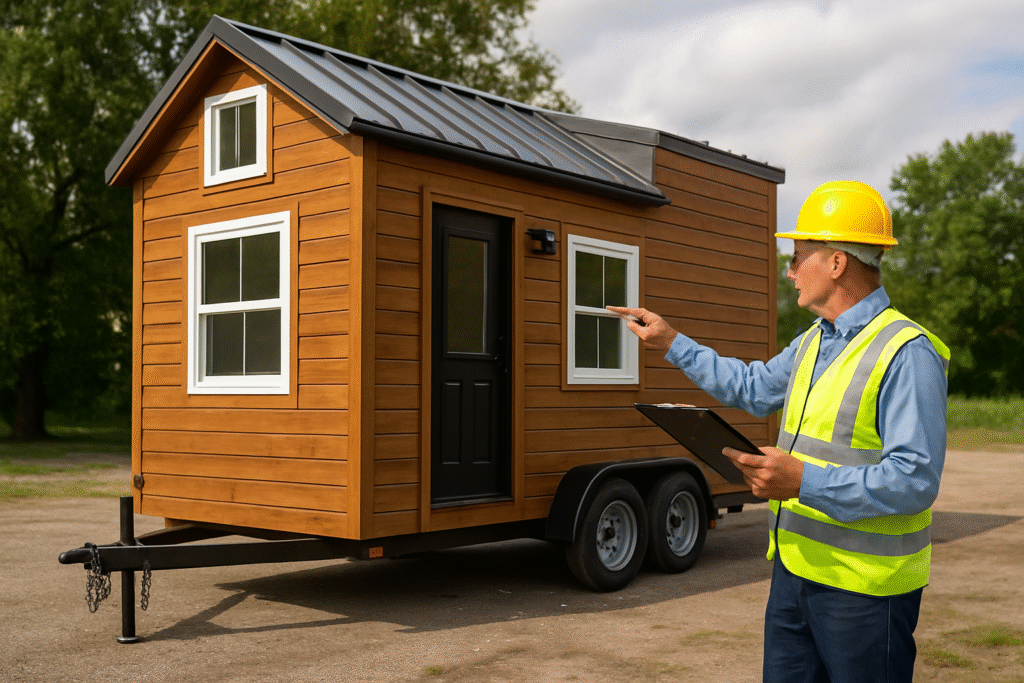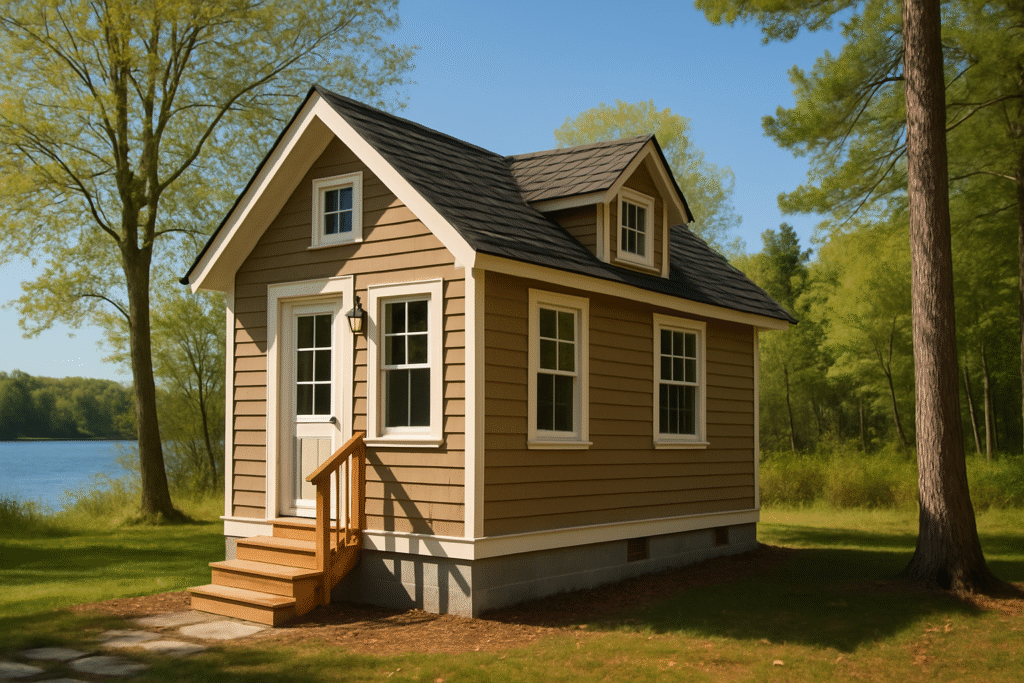Introduction: Unlocking Your Tiny House Dream in the
Great Lakes State
As a tiny house expert, I’ve seen the dream of minimalist living capture the hearts of
many across the nation. The allure of financial freedom, a smaller environmental
footprint, and a life less cluttered is incredibly powerful. If you’re one of the many who
envision a cozy, compact dwelling nestled somewhere beautiful, and your sights are
set on Michigan, you’ve likely asked the burning question: “Are tiny houses legal in
Michigan?”
Table of Contents
It’s a question I hear often, and for good reason. The legal landscape surrounding tiny
homes can be complex, varying significantly not just from state to state, but often from
county to county, and even city to city. Michigan, with its diverse landscapes and
vibrant communities, is no exception. Are tiny houses legal in Michigan? The good news?
Yes, tiny houses can be legal in Michigan. However, the path to making your tiny house dream
a reality in the Great Lakes State requires a clear understanding of the rules, regulations, and local nuances.
This comprehensive guide, straight from an expert in the field, will break down
everything you need to know to navigate Michigan’s tiny house laws successfully.
Understanding the Foundation: Michigan’s Approach
to Tiny Homes
Michigan doesn’t have a single, overarching state law that explicitly defines or
regulates tiny houses as a distinct housing category. Instead, tiny homes typically fall
under existing building codes and zoning ordinances that apply to all residential
structures. This is a crucial point, as it means your tiny house will be subject to the
same requirements as a traditional, larger home, unless specific local ordinances make
allowances.
The Michigan Residential Code and Minimum Square Footage
The primary regulatory framework for residential construction in Michigan is the
Michigan Residential Code (MRC). This code, adopted from the International
Residential Code (IRC), sets standards for safety, health, and welfare in residential
buildings. One of the most significant aspects of the MRC that impacts tiny homes is
the minimum habitable space requirement.

Historically, many building codes, including those in Michigan, mandated minimum
square footage for dwellings that made traditional tiny homes (especially those under
sq. ft.) challenging to permit. However, Michigan has made strides in adapting to
the tiny house movement. As of recent updates, the MRC includes provisions that can
accommodate smaller dwellings. Specifically, for single-family homes, the code often
refers to minimum habitable room sizes. For instance, a living room must be at least
square feet, and other habitable rooms (excluding kitchens) must be at least
square feet. This can be a hurdle for very small tiny homes.
However, there’s a critical nuance: Michigan’s tiny house law allows for smaller
footprints under certain conditions. For example, a tiny house designed for two people
must be at least 250 square feet, while one intended for four people must be at least 450
square feet [1,4]. These specific allowances are vital for tiny home enthusiasts, as
they provide a clear pathway for legal construction within the state’s framework. It’s
important to note that these are minimums for habitable space, and the overall
footprint of the tiny house might be slightly larger to accommodate walls, bathrooms,
and kitchens.
The Local Landscape: Zoning and Ordinances are Key
While the state provides a foundational code, the true complexity—and opportunity—
for tiny homes in Michigan lies at the local level. Zoning ordinances, enacted by
individual counties, cities, and townships, dictate what types of structures can be built
where, and for what purpose. This is where you’ll encounter the most significant
variations and where your research will be most critical.
Navigating Zoning Districts
Every piece of land in Michigan falls into a specific zoning district (e.g., residential,
agricultural, commercial). Each district has its own set of rules regarding:
Minimum Lot Size: How large your property must be to build a home.
Setbacks: How far your home must be from property lines.
Density: How many homes can be built per acre.
Minimum Dwelling Size: While the state has general guidelines, local zoning can
impose stricter minimum square footage requirements, or conversely, create
specific tiny house-friendly zones
.
Foundation Requirements: Whether a home must be on a permanent
foundation or if alternative foundations (like those for tiny homes on wheels) are
permitted.
It’s not uncommon for a township to have a minimum dwelling size of 800
or 1000 square feet, which would effectively prohibit most tiny homes. However, a growing
number of municipalities are beginning to recognize the demand for tiny living and are
amending their ordinances to accommodate them. Some are creating specific tiny
house communities or allowing tiny homes as Accessory Dwelling Units (ADUs).
Accessory Dwelling Units (ADUs): A Pathway for Tiny Homes
ADUs are secondary housing units on a single-family residential lot. They can be
attached to the main house (e.g., a basement apartment), or detached (e.g., a
backyard cottage, which a tiny house could be). The legality of ADUs varies widely by
municipality in Michigan. Where they are permitted, ADUs often have different size
restrictions and requirements than primary dwellings, which can sometimes make
them a viable option for tiny homes that might not meet the primary dwelling
minimums.
If you’re considering an ADU, you’ll need to research your local zoning laws thoroughly.
Key questions to ask include:
Are ADUs permitted in your desired zoning district?
What are the size limitations for ADUs?
Are there specific design or aesthetic requirements?
Can the ADU be rented out, or is it only for family members?
Tiny Homes on Wheels (THOWs) vs. Permanent Foundations
This distinction is paramount when discussing legality. A Tiny House on Wheels
(THOW) is typically built on a trailer chassis and is designed to be movable. From a
legal standpoint, THOWs often fall into a gray area. They are generally classified as
Recreational Vehicles (RVs) or park models, which means they are subject to different
regulations than traditional stick-built homes.

RVs/Park Models: If a THOW is classified as an RV, it’s usually not permitted for
permanent residency in most residential zones. RVs are typically allowed in
designated RV parks or campgrounds for temporary stays. Some municipalities
may allow them on private land for a limited number of days per year.
Permanent Foundations: A tiny house built on a permanent foundation is
generally treated as a traditional dwelling and must comply with the Michigan
Residential Code and local zoning ordinances for permanent structures. This is
often the more straightforward path to legal, long-term tiny home living in
Michigan.
The challenge with THOWs is that many municipalities lack specific ordinances to
address them as permanent residences. This can lead to ambiguity, or worse,
enforcement actions if they are found to be in violation of existing zoning for RVs or
minimum dwelling sizes. Some areas are beginning to create specific zoning for tiny
house communities that can accommodate THOWs, but these are still relatively rare.
The Permitting and Inspection Process
Regardless of whether your tiny house is on a permanent foundation or a THOW
intended for permanent placement (where permitted), you will almost certainly need
permits and inspections. This is where many aspiring tiny home owners can get
tripped up.
Building Permits
A building permit is required for most new construction or significant alterations to
existing structures. This ensures that your tiny home meets safety standards, including
structural integrity, electrical systems, plumbing, and energy efficiency. The permit
application process typically involves submitting detailed plans for review by the local
building department.
Zoning Permits
In addition to a building permit, you’ll likely need a zoning permit. This permit
confirms that your proposed tiny house complies with the local zoning ordinances for
your property, such as setbacks, lot coverage, and use. Be sure to see Tiny House Legalities: Zoning Laws and Regulations Across the U.S.
Inspections
Throughout the construction process, various inspections will be required (e.g.,
foundation, framing, electrical, plumbing, final). These inspections ensure that the
construction adheres to the approved plans and all applicable codes. Failing to obtain
necessary permits or pass inspections can lead to stop-work orders, fines, or even the
requirement to remove the structure.
Finding Tiny House-Friendly Locations in Michigan
Given the localized nature of tiny house legality, finding a tiny house-friendly
community or municipality is paramount. Here’s how to approach your search:
Research Specific Municipalities: Don’t assume. Contact the planning and
zoning departments of the specific cities, townships, or counties you’re
interested in. Ask direct questions about:
Minimum dwelling size requirements.
ADU allowances and regulations.
Whether tiny homes on wheels are permitted for permanent residency.
Any specific tiny house ordinances or communities.
Look for Tiny House Communities: Some areas in Michigan are actively
developing or have established tiny house communities. These communities
often have pre-approved zoning and infrastructure for tiny homes, simplifying
the process significantly.
Consult with Experts: Engage with local tiny house builders, real estate agents
specializing in tiny homes, or tiny house advocacy groups in Michigan. They often
have up-to-date information on friendly jurisdictions and can offer invaluable
advice.
Review Local Ordinances Online: Many municipalities publish their zoning
ordinances online. While these can be dense, they are the definitive source of
information.
Common Challenges and Pitfalls
Even with the increasing acceptance of tiny homes, challenges remain:
Lack of Specific Definitions: The absence of a clear, statewide definition for
“tiny house” can lead to interpretation issues at the local level.
NIMBYism (Not In My Backyard): Existing residents may oppose tiny homes due
to concerns about property values, aesthetics, or perceived impacts on
neighborhood character.
Financing: Obtaining traditional mortgages for tiny homes, especially THOWs,
can be difficult due to their classification and lack of comparable sales data.
Utilities: Ensuring proper hookups for water, sewer, and electricity that comply
with codes can be complex.
Conclusion: Your Tiny House Journey in Michigan is
Possible!
Building or placing a tiny house in Michigan is absolutely achievable, but it requires
diligence, research, and a proactive approach. As a tiny house expert, my advice is
always to start with thorough due diligence on local zoning and building codes before
you commit to a location or a build. Understand the distinction between tiny homes on
wheels and those on permanent foundations, and be prepared to navigate the
permitting and inspection processes.
Michigan is a state with a growing interest in sustainable and alternative living, and its
legal framework is slowly but surely evolving to accommodate the tiny house
movement. By being informed, patient, and persistent, you can turn your tiny house
dream into a comfortable, legal reality in the beautiful state of Michigan. Happy tiny
living!

